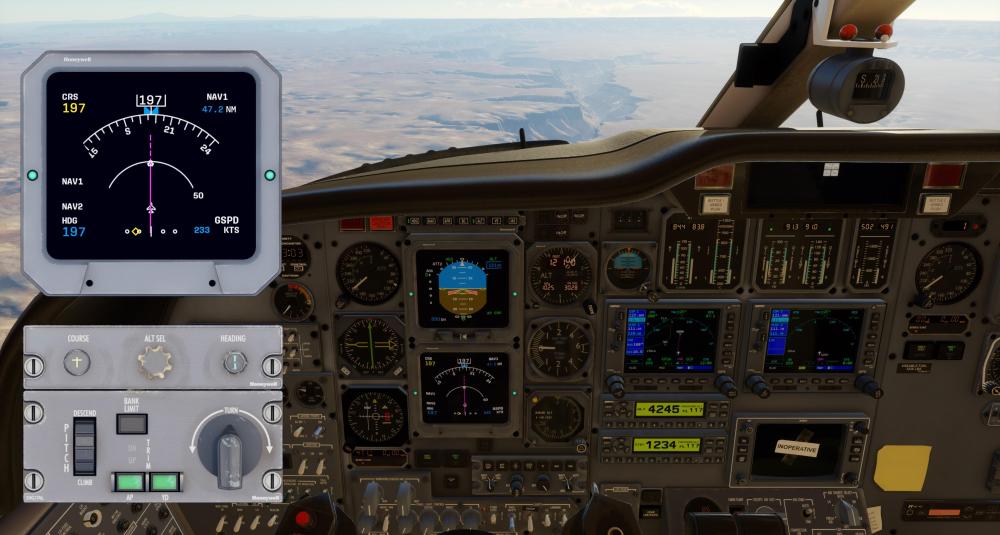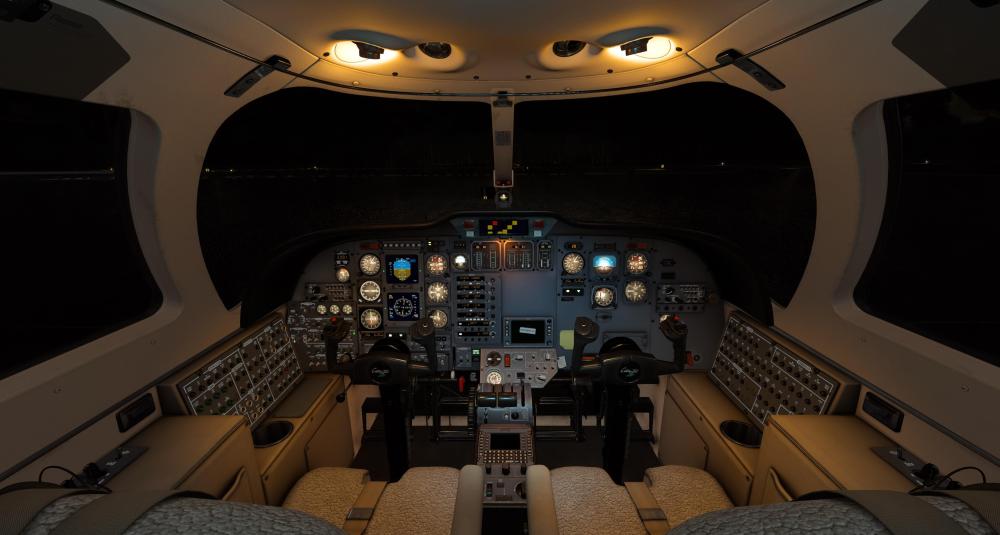Leaderboard
Popular Content
Showing content with the highest reputation on 12/04/2024 in all areas
-
Captains, We hope you are as excited about the Take Command! TorqueSim CitationJet 525 as we are! We are in the home stretch of finishing up the final features and testing, and are aiming to get this product released very soon. Let’s take some time and dig into the unique and detailed avionics featured in this aircraft. The key centerpiece of the aircraft is the Honeywell avionics system including the ED-600 EFIS (Electronic Flight Instrument System) displays: the EADI (Electronic Attitude Director Indicator) and EHSI (Electronic Horizontal Situation Indicator). These are the two primary displays on the captain’s side of the panel. These displays are controlled by the DC-81X display controller located below the EHSI. To the right of the EADI is the Honeywell AM-250 altimeter, an advanced RVSM-capable altimeter. The aircraft’s Honeywell autopilot consists of the mode selector located above the EADI and the control panel located on the center pedestal. The EADI features many unique attributes: Standard attitude sphere for indicating pitch and roll, capable of being driven by the reversionary attitude gyro “ATT2” Selectable single cue and cross pointer flight director command cues Fast/Slow angle of attack display for dialing in your perfect approach Rising runway indication for enhanced situational awareness Radio altimeter readout Decision height setting and alerting Flight director mode indications and attribute displays Integrated marker beacon indicators On approaches, glideslope and expanded localizer display. The expanded localizer display replaces the rate-of-turn indication and instead shows a high-sensitivity localizer deflection indication, 7.5x the amplification to provide precision tuning and awareness of aircraft location within the center of the localizer. The EHSI also has many distinctive behaviors and features: Standard HSI mode, with course and deviation, providing a familiar experience to most pilots Arc HSI mode, which expands the HSI view to show a smaller range of angles ahead, but with enlarged indications for easier viewing Map viewing mode, with multiple distinct viewing options: When tuned to a NAV radio, and the selected NAV radio is receiving an appropriate VOR, the map will enter SRN (short range navigation) mode, where it utilizes DME and bearing values to generate a map based on received signals. This provides for much clearer flying behaviors when using VOR navigation. Underneath the map, a standard horizontal deviation indicator is displayed to reinforce what you are seeing on the map. When set to the UNS1 FMS source, it displays the current flight plan ahead of the aircraft, including waypoint names, turns, arcs, and holds. This is the airliner-esque navigation display you may be familiar with from larger aircraft and other modern GA avionics. Bearing pointers from NAV1/NAV2/ADF1/ADF2/FMS sources Heading bug connected to the autopilot Glideslope indication shown when appropriate DME display Interchangeable ground speed, time-to-go, and elapsed time display The Honeywell autopilot is driven by a fully-custom flight director with various modes: Heading hold mode, where the current heading is flown. In this mode, the aircraft can be controlled in a constant-bank turn using the turn knob on the pedestal autopilot control panel. Pitch hold mode, where the aircraft’s pitch attitude can be modified through the pitch knob on the autopilot control panel. Heading select mode, a classic autopilot control mode where the system flies the specified magnetic heading, as set on the autopilot control panel and displayed on the EHSI. NAV mode, where the autopilot can follow the various NAV sources, as fed to the EHSI APR mode, where the autopilot can also follow a glideslope (or emulated glideslope provided by an installed GPS unit, if equipped -- more on that later) Backcourse mode, for following a localizer outbound with reverse-deflections Altitude select and hold modes, with a preselector set via the autopilot control panel Vertical speed and indicated airspeed modes where you can specify the climb rate or speed via the knob on the autopilot control panel A novel and distinctive part of this aircraft is the wide range of navigation systems that can be used. We’ve spent an immense amount of time building out these integrations to ensure a wide range of flying types and needs are met. The Universal UNS-1 Flight Management System is located on the aircraft’s center pedestal and is present in all configurations. The UNS-1 can always drive the EHSI and flight director via the “FMS” mode on the display controller. Flight Plan Management: Create, edit, and store complex flight plans with multiple waypoints, including support for airways and terminal procedures. Advanced Navigation: Use direct-to, pseudo-VOR, holding patterns and lateral offsets Updatable database: Utilizes the X-Plane 12 navigation database, which can be updated via Navigraph. Performance Monitoring: Tracks fuel usage, estimated time en route, and wind impact for enhanced situational awareness. Integration with EHSI: Seamlessly drives navigation displays with real-time depiction of waypoints, flight plan legs, and guidance cues. The Standard Config: Honeywell CNI-5000 Integrated Avionics System. This is the classic radio assortment shipped with the aircraft. This features 2 COM radios, 2 NAV radios, an ADF receiver, as well as dual transponders with an active selection switch. Dual X-Plane GNS530: Two GNS units are mounted on the panel, replacing the CNI-5000. These navigators add a key capability to the aircraft: Vertical guidance on RNAV approaches. These units drive the EHSI/FD via the NAV1/NAV2 channel for the left and right GNS, respectively. This means you can utilize the FMS and both GNS radios at the same time, while also having access to the NAV radios. Switching the output of the GNS between GPS and the NAV radio is accomplished using the “VLOC” button on the navigator. With this configuration, two GTX 327 transponders are added to the panel. Dual GTN750Xi: We are thrilled to announce full integration with the upcoming TDS Sim GTNXi for X-Plane! (sold separately, Windows only) This will be coming in the next few months. We have been working with TDS on integrating their GTN750Xi navigator into the aircraft and we think that you’ll love it. Enjoy the feature set and capabilities of the GTN750Xi system, with many new features for the X-Plane market. A massive addition of this system is updatable navigation data and charts through Navigraph! The CJ525 is equipped with dual GTN750Xi navigators in this configuration, with advanced RNAV approach capabilities including vertical guidance. Simulated is the GTN Xi series (V20.x) including many enhancements from the original GTNs including higher resolution maps, faster overall usage, SmartGlide, etc Worldwide charts, fully integrated and geo-referenced into the GTNXi, from Navigraph RealSimGear hardware support For more information and to follow TDS’s progress, you can follow them directly on discord or their website. RealityXP GTN750 and GNS530: (sold separately, Windows only). The aircraft can be equipped with dual GTN750s or dual GNS530s. These tie into our systems in a similar manner as described above using the RXP GPS options. Some additional equipped avionics systems include: An approach indexer display mounted on the center column of the windshield. This system aids in flying stable approaches with the optimal angle of attack indicated as well as too fast / too slow indications. This system was modeled with custom lighting to ensure a vivid and beautiful effect, especially at night. Dual DMEs with hold capability, with distance, speed and time read-outs Copilot KI525A HSI with free/slaved gyro Pilot side dual RMI with NAV/ADF selections Pilot side course deviation indicator for the NAV1 primary source Davtron M877 Chronometer with GMT, LT (local time), ET (elapsed time), and FT (flight time) We hope this post helped illustrate how the Take Command! TorqueSim CitationJet 525 offers a remarkable set of unique and detailed avionics to provide an immersive flying experience. Every system, from the Honeywell EFIS displays to the advanced navigation configurations, has been meticulously crafted to provide both realism and versatility for pilots of all skill levels. Whether you prefer flying with traditional VOR navigation or leveraging the latest FMS and GPS integrations, this aircraft is designed to deliver precision, performance, and depth. We can’t wait for you to experience the innovation and passion poured into this project -- more to be shared soon! Have a Happy Thanksgiving holiday weekend!1 point
-
1 point
-
Version 1.0.0
93 downloads
This is a livery for the Hot Start Challenger 650, inspired by https://www.jetphotos.com/photo/10660488 To install, extract the zip file into the "liveries" folder. You can supply your own registration, C-GZUM is not printed on the cowlings. This livery is in 8K. Hello Pilsner1 point -
Version 1.0.0
167 downloads
This package will replace the default instrument approach charts on the yoke with a selection of power and speed charts. The data is derived from the charts.pdf provided with the aircraft, speeds are based on Sea Level and 0 degrees celcius. Being a turbo-prop, the difference in most speeds are only a few knotts and makes a compromise for the limited chart space. To select the chart to be displayed, click on the 'charts' icon towards the bottom of the gizmo toolbar (the one that looks like line graphs). Includes: * Climb Power and ECS OFF Takeoff Power * Cruise Power and ECS ON Takeoff Power * Selection of Metric or Imperial weight Speed Charts1 point -
1 point















